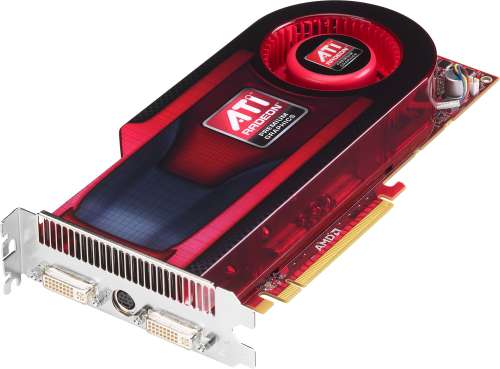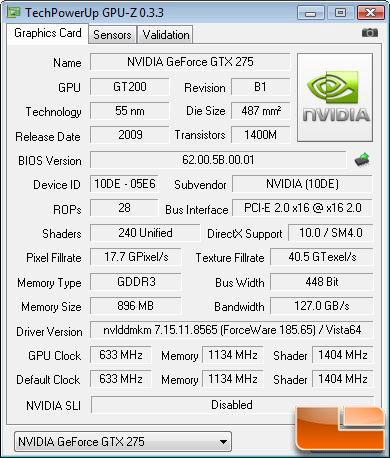NVIDIA
| GTX 285 | GTX 275 | GTX 260 Core 216 | GTS 250 / 9800 GTX+ | |
| Stream Processors | 240 | 240 | 216 | 128 |
| Texture Address / Filtering | 80 / 80 | 80 / 80 | 72/72 | 64 / 64 |
| ROPs | 32 | 28 | 28 | 16 |
| Core Clock | 648MHz | 633MHz | 576MHz | 738MHz |
| Shader Clock | 1476MHz | 1404MHz | 1242MHz | 1836MHz |
| Memory Clock | 1242MHz | 1134MHz | 999MHz | 1100MHz |
| Memory Bus Width | 512-bit | 448-bit | 448-bit | 256-bit |
| Frame Buffer | 1GB | 896MB | 896MB | 512MB |
| Transistor Count | 1.4B | 1.4B | 1.4B | 754M |
| Manufacturing Process | TSMC 55nm | TSMC 55nm | TSMC 65nm | TSMC 55nm |
| Price Point | $360 | ~$250 | $205 | $140 |
ATI RADEON
| ATI Radeon HD 4890 | ATI Radeon HD 4870 | ATI Radeon HD 4850 | |
| Stream Processors | 800 | 800 | 800 |
| Texture Units | 40 | 40 | 40 |
| ROPs | 16 | 16 | 16 |
| Core Clock | 850MHz | 750MHz | 625MHz |
| Memory Clock | 975MHz (3900MHz data rate) GDDR5 | 900MHz (3600MHz data rate) GDDR5 | 993MHz (1986MHz data rate) GDDR3 |
| Memory Bus Width | 256-bit | 256-bit | 256-bit |
| Frame Buffer | 1GB | 1GB | 512MB |
| Transistor Count | 959M | 956M | 956M |
| Manufacturing Process | TSMC 55nm | TSMC 55nm | TSMC 55nm |
| Price Point | ~$250 | ~$200 | $150 |




The fact that its worst-case performance is still better than the GTX 260 core 216 and in the best case, it can hit that of the GTX 280 was a plus for the GTX 275. It often posted performance more in line with its bigger brothers than a $50+ cheaper part. This is pretty sweet for a $250 card, especially as many games these days rely very heavily on shader performance. The GeForce GTX 275 is a good fit for this price point, and is a good option. But then there's the Radeon HD 4890.
The 4890, basically a tweaked and overclocked 4870, does improve performance over the 4870 1GB and puts up good competition for the GTX 275. On a pure performance level the 4890 and GTX 275 trade blows at different resolutions. The 4890 tends to look better at lower resolutions while the GTX 275 is more competitive at high resolutions. At 1680 x 1050 and 1920 x 1200 the 4890 is nearly undefeated. At 2560 x 1600, it seems to be pretty much a wash between the two cards.
At the same time, there are other questions, like that of availability. With these parts performing so similarly, and price being pretty well equal, the fact that AMD parts can be bought starting today and we have to wait for the NVIDIA parts is an advantage for AMD. However, we have to factor in the fact that AMD driver support doesn't have the best track record as of late for new game titles. Add in the fact that NVIDIA's developer relations seem more effective than AMD's could mean more titles that run better on NVIDIA hardware in the future. So what to go with? Really it depends on what resolutions you're targeting and what the prices end up being. If you've got a 30" display then either card will work, it's just up to your preference and the items we talked about earlier. If you've got a 24" or smaller display (1920x1200 or below), then the Radeon HD 4890 is the card for you.


No comments:
Post a Comment